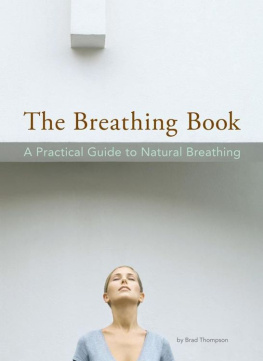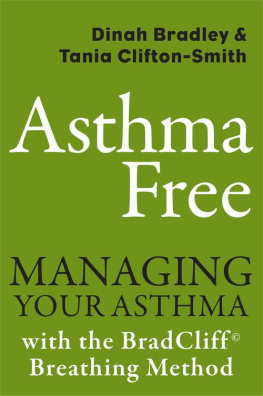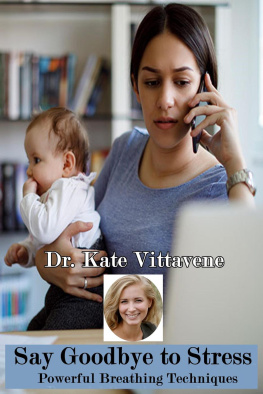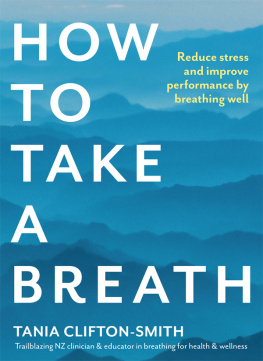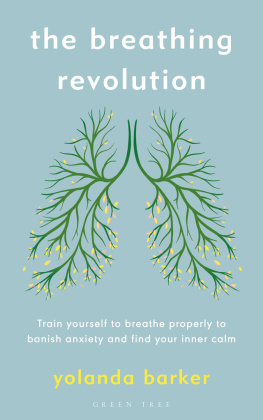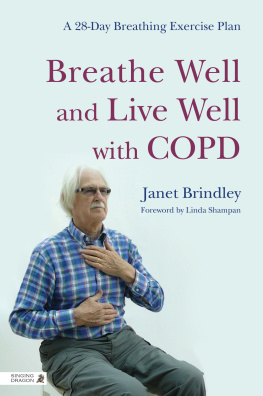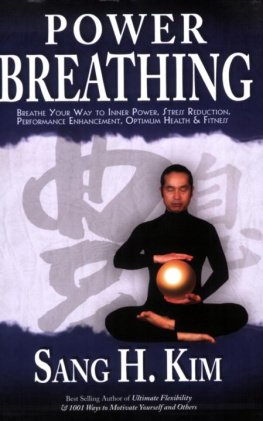CONTENTS
.
.
Introduction
To stay alive there are three vital needs that must be met. We need to eat food to nourish ourselves, we need to drink water for hydration, and we need air to breathe. It is possible to go without food for quite some time, two to three weeks at least. Water is a little more critical, we cannot go without it for more than two or three days. Airtwo to three minutes without air and our life is over. Breathing is the most important intake of energy we need to do to stay alive. Yet most people go through their whole lives rarely focusing on their breath.
When was the last time you thought about your breathing? Really paid attention to it, and consciously tried to do better? Cant remember? You are not alonemost people simply forget about their breathing, taking it for granted. Consequently, they fall into poor breathing habits.
Every cell in your body needs oxygen to function properly. Poor or inadequate breathing contributes significantly to a wide range of health and wellness issues, increasing the impact that the stress of modern living has on our lives.
This book will help you better understand the physiology and mechanics of breathing. It will teach you to improve your breathing in areas such as capacity, control and flexibility. You will learn to restore your natural breathing, and adapt your breath to different activities. Discover how to conquer stress, gain more energy, exercise more efficiently, loose weight and think more clearly. Youll be surprised how easy it really is, and will be left wondering why we are all not taught this from a young age.
If you are kind of breathing as you read thisthen this book is for you!
One:
Born to Breathe
Why do we forget to breathe naturally?
If you woke up breathing, congratulations! You have another chance
Andrea Boydston
I felt invigorated without fatigue or gasping for breath
Jenny

I did the breathing session while staying at a health resort, where my accommodation was a 10 minute uphill walk that left me breathless. Brad announced that he was going to teach a method that would make the climb easy. This was met with smiles of knowing disbelief from most of the participants. To our amazement, the first time we put the lesson into practise our whole group did the trek effortlessly. We could chat to each other on the way up, and arrived in record time. I felt invigorated without fatigue or gasping for breath. I still wonder how I had managed to get to 57 years old without knowing this
To many people, the notion of breathing poorly is ludicrous. How do you not breathe well? Isnt it the most natural thing in the world? It should be, but in fact most people go through much of their lives unable to experience the comfort and pleasure of breathing naturally, let alone undertake any kind of exercise without struggling for air. Why is this?
From the moment we are born we are breathing machines. Observe a baby breathing and see how effortless and natural it is. If the baby is calm and happy, his or her little tummy moves gently up and downif the baby is upset and crying then much more of the chest and ribs are involved. The baby does what is physiologically normal. It has learnt no habits, good or bad, it just breathes.
So when and how do we forget to breathe naturally? When do we begin to unconsciously sabotage ourselves into breathing badly? What are the consequences of this? Many of the reasons why breathing becomes shallow or labored can be traced back to our childhood, when we started to develop our own unique patterns of functioning.
Childhood habits
Remember as a child being told stand up straight dont slouch? Parents are well meaning in issuing this instruction, not wanting their child to develop poor posture. So you drew your shoulders back, lifted your chest, pulled in your stomach and tilted your head back, doing your best impersonation of a catwalk model or a body builder. This culturally accepted version of good posturein fact, an unnatural, over-corrected postureis responsible for creating such a false stiffness in the body that discomfort or pain is often the result, with breathing limited to the upper chest.
Childhood asthma has also become more and more widespreadone theory is that asthma may be exacerbated by the tendency of children to breath through the mouth. Infant mouth breathing could begin in a child who has a succession of head colds, blocked or constant runny nose. The nose is the natural breathing organ, and under normal, calm conditions should be doing almost all of the breathing. The filament hairs of the nose filter dust and impurities as we breathe, and the mucous membranes act as a thermostat to warm or cool air before it goes into our lungs. This natural thermostat helps to protect our lungs by filtering and preparing the air for absorption. This explains why in cold weather we often experience a runny nose. It is just our thermostat dripping!
In eastern medicine mouth breathing is considered particularly unhealthy. If you are in the habit of breathing through your mouth, addressing this should be your first priority in restoring natural, healthy breathing. If your child is starting to develop mouth breathing habits then everything should be done to help them overcome this and breathe naturally through their nose.
The processes and mechanisms of the inhalation of air
The lungs are driven by the autonomic nervous system. This part of the nervous system is responsible for all the unconscious actions that the human organism must carry out moment to moment to ensure life goes on. When you eat you dont have to sit down and consciously control the metabolic processes that look after digestionthey happen automatically. Similarly, you dont have to concentrate on circulating blood around the body or creating the many chemicals that are required to ensure healthy functioning. This is your autonomic nervous system at work. It is this system that is the automatic pilot looking after your breathing when you are not thinking about itwhich is most of the time.
However, unlike processes such as digestion and metabolic function, it is possible to be conscious of and in control of our breathing. Most people are happy to forfeit control of their breathing to the auto pilot, unaware that they in fact have a choice. Many people with serious breathing problems bronchial illnesses, cystic fibrosis, panic attacks, and people who have had lung surgery, and also many relatively healthy people who feel that their breathing is just not what it could bedo not realize that it is possible to do something about it.
During our waking, active life, we generally function in a vertical relationship to gravity; there is therefore a tendency for blood to pool in the lower lobes of the lungs. Abdominal breathing, which is to breathe in as if the air is expanding into your abdomen, draws the oxygen down into the lower lungs, ensuring the maximum efficiency in absorption. Abdominal breathing is diaphragmatic breathing. The diaphragm is the primary muscle in the action of breathing. Other contributing muscles include the intercostal muscles between the ribs, the abdominal or core muscles and the pelvic diaphragm.

The results were significant immediately
Nicholas


